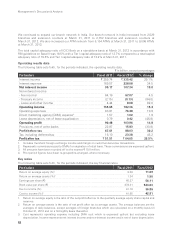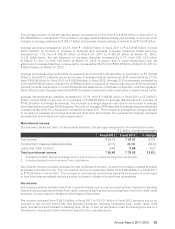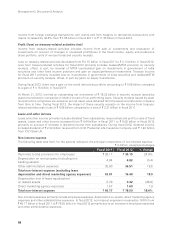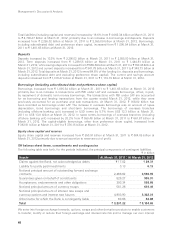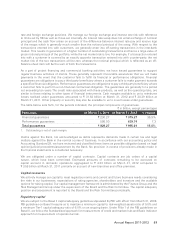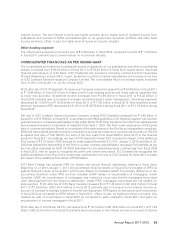ICICI Bank 2012 Annual Report Download - page 63
Download and view the complete annual report
Please find page 63 of the 2012 ICICI Bank annual report below. You can navigate through the pages in the report by either clicking on the pages listed below, or by using the keyword search tool below to find specific information within the annual report.
Annual Report 2011-2012 61
rate and foreign exchange positions. We manage our foreign exchange and interest rate risk with reference
to limits set by RBI as well as those set internally. An interest rate swap does not entail exchange of notional
principal and the cash flow arises on account of the difference between interest rate pay and receive legs
of the swaps which is generally much smaller than the notional principal of the swap. With respect to the
transactions entered into with customers, we generally enter into off-setting transactions in the inter-bank
market. This results in generation of a higher number of outstanding transactions and hence a large value of
gross notional principal of the portfolio, while the net market risk is low. For example, if a transaction entered
into with a customer is covered by an exactly opposite transaction entered into with counter-party, the net
market risk of the two transactions will be zero whereas the notional principal which is reflected as an off-
balance sheet item will be the sum of both the transactions.
As a part of project financing and commercial banking activities, we have issued guarantees to support
regular business activities of clients. These generally represent irrevocable assurances that we will make
payments in the event that the customer fails to fulfill its financial or performance obligations. Financial
guarantees are obligations to pay a third party beneficiary where a customer fails to make payment towards
a specified financial obligation. Performance guarantees are obligations to pay a third party beneficiary where
a customer fails to perform a non-financial contractual obligation. The guarantees are generally for a period
not exceeding ten years The credit risks associated with these products, as well as the operating risks, are
similar to those relating to other types of financial instruments. Cash margins available to us to reimburse
losses realised under guarantees amounted to ` 31.63 billion at March 31, 2012 and ` 24.39 billion at
March 31, 2011. Other property or security may also be available to us to cover losses under guarantees.
The table below sets forth, for the periods indicated, the principal components of guarantees.
` in billion, except percentages
Particulars At March 31, 2011 At March 31, 2012 % change
Financial guarantees ` 230.27 ` 315.27 36.9%
Performance guarantees 596.00 639.74 7.3
Total guarantees ` 826.27 ` 955.01 15.6%
1. Outstanding is net of cash margin.
Claims against the Bank, not acknowledged as debts represents demands made in certain tax and legal
matters against the Bank in the normal course of business. In accordance with our accounting policy and
Accounting Standard 29, we have reviewed and classified these items as possible obligation based on legal
opinion/judicial precedents/assessment by the Bank. No provision in excess of provisions already made in
the financial statements is considered necessary.
We are obligated under a number of capital contracts. Capital contracts are job orders of a capital
nature, which have been committed. Estimated amounts of contracts remaining to be executed on
capital account in domestic operations aggregated to ` 4.33 billion at March 31, 2012 compared to
` 3.58 billion at March 31, 2011 primarily on account of new branches and office premises.
Capital resources
We actively manage our capital to meet regulatory norms and current and future business needs considering
the risks in our businesses, expectations of rating agencies, shareholders and investors and the available
options for raising capital. Our capital management framework is administered by the Finance Group and the
Risk Management Group under the supervision of the Board and the Risk Committee. The capital adequacy
position and assessment is reported to the Board and the Risk Committee periodically.
Regulatory capital
We are subject to the Basel II capital adequacy guidelines stipulated by RBI with effect from March 31, 2008.
RBI guidelines on Basel II require us to maintain a minimum capital to risk-weighted assets ratio of 9.0% and
a minimum Tier-1 capital adequacy ratio of 6.0% on an ongoing basis. Under Pillar 1 of the RBI guidelines on
Basel II, we follow the Standardised approach for measurement of credit and market risks and Basic Indicator
approach for measurement of operational risk.



